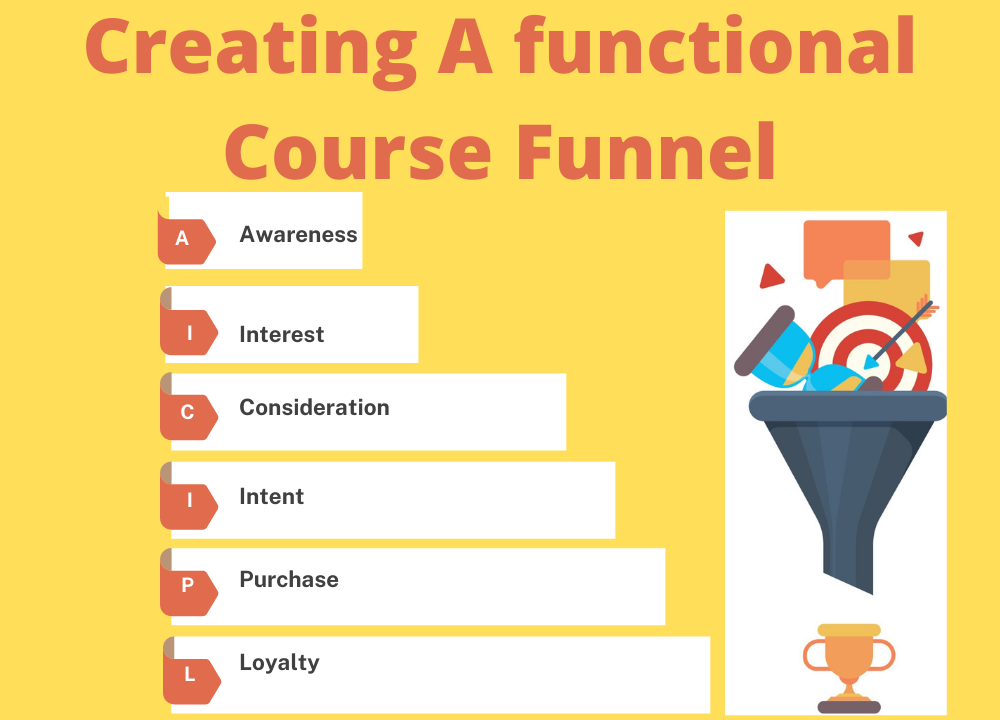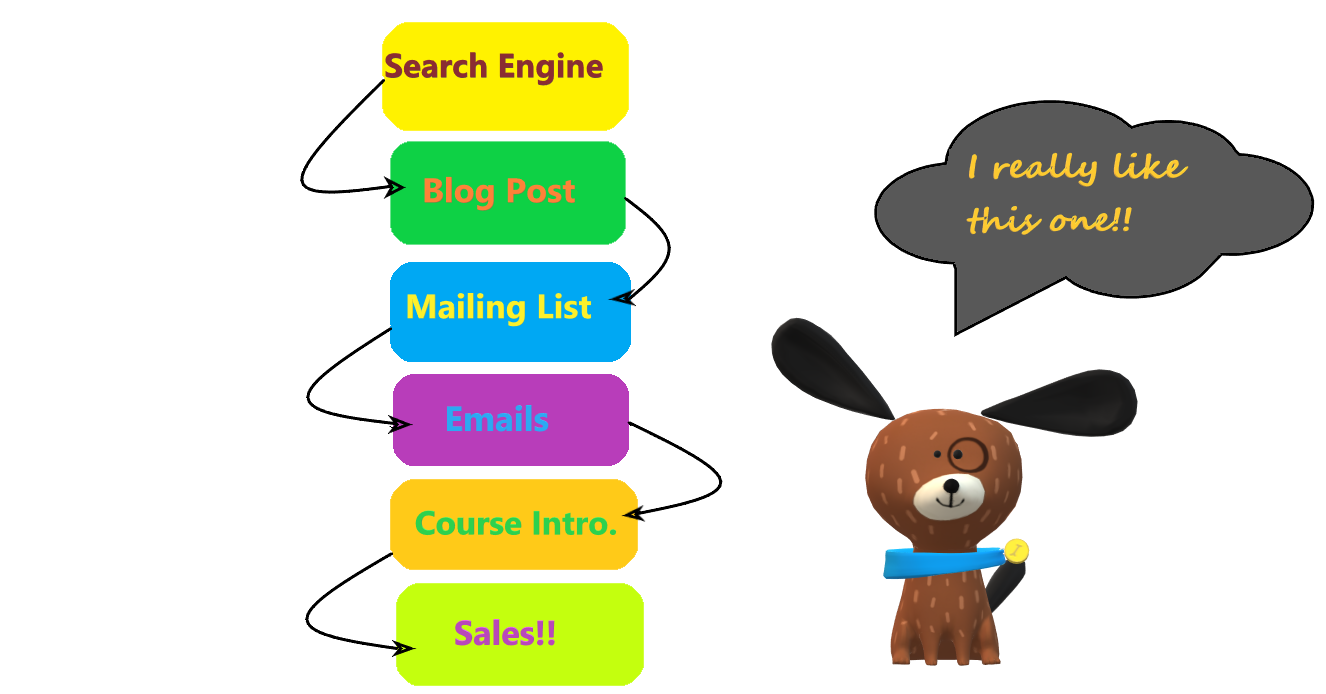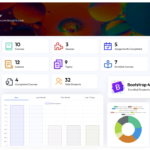
When you design a sales funnel specifically for your course sale, it is called a course funnel. A sales funnel includes the whole process of attracting interested people and turning them into paying customers.
It includes different strategies like email marketing, blogging, guest posting, social media marketing etc. but in a coherent way.
According to Tyler Basu at Thinkific, if you have a perfect course without an audience to buy it, it’s like you have a lemonade stand in the scratching heat of a desert. Your lemonade can be pretty delicious and the high temperature of the desert is the perfect weather to sell it but there are no people to buy it.
You can be the expert in your field and you have a perfect course, but without an effective course funnel, you might not get the optimum return.
Table of Contents
ToggleHow to Build an Effective Course Funnel?
A course funnel has several steps through which a buyer passes until a purchase is made. It can have up to 8 steps according to the specific marketing field. We have divided the course funnel into six effective stages.
- Awareness
- Interest
- Consideration
- Intent
- Purchase
- Loyalty
We will discuss each step with the relevant examples and methods. Let’s dive in to build your course funnel with our easy and effective strategies.
1. Awareness:
Awareness is getting familiar with your target market and understanding their problems. If you have not yet built your course, you can check the most common issues in your expert area and make a course on those problems. If you have already built your course, now you need to identify the market which will be interested in buying it.
In both ways, you have to become familiar with your potential audience and you also have to create awareness that a solution to their problems actually exists in the form of your course. But how will you tell them about the solution if you don’t even know their problems?
So, the first step is to identify your target market and know what they are struggling with and what are their pain points. Then, you can start your course funnel by pressurizing on those specific issues and problems.
Here are a few ways to get in touch with your audience.
Strategies for Awareness:
Social media: Search Facebook groups in your specific niche and join them. See what are the problems that people are most worried about.
The same is with the LinkedIn groups. First, just observe your target market and note down their problems. You can also offer advice and free resources as well. You can also make your own group which will later help in your marketing as well.
For Instagram and Twitter, use hashtags and the relevant accounts and posts will be opened. Do your research and observe what people are mostly talking about. You can also try to get in touch with the influencers in your industry and build connections.
Reddit: Read threads relevant to your course niche. You will get an idea of your potential customers.
Quora: Many experts emphasize getting involved and responding to queries on quora. It will not only help to understand the target market but it will also help you to stand out as an expert in your industry.
Online forums: There are online forums for every niche. Search on Google and analyze the information provided on these forums.
Market Research: If you have enough budget, you can run your own market testing with softwares like surveymonkey.com and find your target audience.
2. Interest:
Once you have got familiar with your potential clients and you know what problem your course is solving for them, now you have to build their interest to learn more and get engaged through your free offers.
Yeah, you heard us right. We can not offer them our course to purchase without even making them comfortable with the level of expertise and information which they will be getting in return.
You have to engage them while showing a sneak peek of your knowledge and experience. This stage is also called lead generation is marketing language where you are turning your target audience into an interested audience. To read more about lead generation and lead nurturing, check our articles on Email Marketing.
Strategies for Interest:
Most people provide informative material to gain the interest of potential clients. It can be through writing blogs, creating YouTube videos, doing live webinars, or writing posts on already established blogs.
You can create useful posts on your own or other social media groups and bring all the audience to your website by linking it to your posts, YouTube videos, etc.
When you have identified a specific problem that you are going to resolve, start writing blogs. Blogs are a great way to bring traffic to your website and help others while satisfying them with your knowledge and expertise as well.
If you are writing blogs, you can also provide a link to those blogs on these social media channels and bring traffic to your website.
Secondly, you need to build your mailing list with the emails of those people interested in your content. You offer them a free resource like a cheat book, checklist, eBook, how-to’s or any other informative material if they subscribe to your mailing list.
In this way, you send them free material or resources weekly or on any timeline which you prefer, to keep them engaged.
3. Consideration:
Once you have attracted subscribers or followers to your content, the next stage is to make them consider your purchased course. But, most of the people suggest doing this by a drip campaign.
A drip campaign is a series of emails designed in a way to take the attention of the targeted market to your offer in a step-by-step manner.
If you will throw your offer all at once, there is a lower chance that anyone would consider it. People need to have a constant reminder that a solution to their problems exists.
Moreover, they have many questions about the product, its effectiveness and how it will solve their problems. You should first introduce yourself and your products and then ask them to give it a try.
Strategies for Consideration:
This is where our marketing automation software comes in handy. You can easily automate the whole process of sending emails to your mailing list without doing any monotonous tasks. The purpose of these emails will be to first welcome your leads.
Then nurture or engage them with the content that you provide as blogs or videos and keep them interested by quizzes or surveys or any other tactic that could work for it.
Now, it’s your power to analyze what type of content is most appealing to your subscribers, if they are opening emails continuously or not. Lead nurturing is a way to show relevant content to your leads according to their interest. If you become successful in engaging them, they are most likely to get the purchase.
You can also score a person based on the activities on your website. If he is more likely to go towards the purchase, you can give him a higher score. If he moves back and does not open further emails, you can score him lower and then try to change your marketing strategy for such people.
4. Intent:
This is the step where you actually make your sales pitch. Here, you can first discuss the very problem which your course will be solving, then provide the solution and at the end introduce your course. A catchy email without any enforcement or hard-sell can be more effective than asking them repeatedly to buy the course.
Also, people could have many objections like paying the upfront cost, whether the course provides what it says or if they would get enough expertise to apply the knowledge. You can remove their objections by deliberately explaining the benefits and practical implementation of your course.
Strategies for Intent:
You can add in your video explaining how your course will help in gaining the desired benefits.
If you have any losing leads, offer them coupons or discounts if they purchase immediately. You can also use the strategy of offering your course in a limited time.
It creates an urgency to enroll now or never and assists the potential buyers in making decisions. Another strategy is to offer 1 or 2 lessons for free so the objections can be cleared.
When a person subscribes to your email list, the consideration and then the intent stage begins. So, the follow-up email series can be like this,
Day 1: Welcome Email with your introduction and the freebie which you promised
Day 3: Link to your latest blog posts
Day 7: Link to your latest blog posts
Day 9: Introduction to your course and the benefits it provides (It may include an invitation to a video or a live webinar where you discuss your course briefly)
Day 11: Limited time offers of coupons and discounts/ offer to watch 1 or 2 lessons free
Day 13: FAQs
Day 15: Only a few hours remaining till the course is closed
5. Purchase:
Hurray!! Your course has high sales due to your huge marketing efforts. This was the one thing for which you did so much effort and finally, you gained results because you were able to gain the trust of your potential clients.
This is usually the last step in the course funnel where the purchase has been made as this was your ultimate goal to convert your leads into sales. However, the hidden key is to make loyal customers, who are never going to leave you even if one course ends.
Strategies for Purchase:
Make sure your sales pitch has a catchy headline and an engaging story about yourself and the pain points that you went through and now you are trying to make things easy for other people. Tell them how they are ultimately going to save money by learning the skill themselves rather than paying others.
You can also offer a 30-day money-back guarantee to further reduce their doubts. If they are not satisfied with your course, they can have their money back.
Obviously, you may have issues concerning content privacy which is a solvable problem to some extent by offering drip-feed content. However, once the month passes, you will have a team of most sincere learners, who really want to learn and become your loyal customers as well.
6. Loyalty:
Loyalty is the last step of an effective course funnel. You can make your students your advocates by winning their loyalty. They will refer your course to others and create word-of-mouth. They might get interested in other courses or services which you offer.
Converting learners who have already purchased your course is easier than finding new potential customers. Established learners are already satisfied with the value you provide, and your authority as an educator and they have actually paid the price to learn from you.
Strategies for Loyalty:
The first step is to deliver what you offer. Fake promises do not run a long way. If you remain sincere with the learners, they will trust you in return.
Second thing is to make them feel valued. Ask for their feedback once the course has finished. Did they have any issues? How was the overall experience? Are they satisfied or not? They will provide some practical suggestions as well which will be very helpful to improve your course.
Keep sending them newsletters and new blog posts to keep them engaged. This will keep your business present in their minds. Keep them informed about new courses and their release dates. If you have brought your target market to this stage, you have truly mastered the course funnel.
Conclusion:

In this article, we have provided you guys with an overview of what a course funnel is and how you can make one by combining and implementing multiple strategies.
There is nothing like a perfect practice that will work in any industry. You will still have to figure out what really works for your niche and your clients by testing multiple things. You can make multiple course funnels and run them simultaneously to figure out what works best for you. We are always here for any support and advice.
If you want to know tips for effective course creation, check our blog post here. Keep growing…









